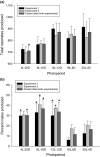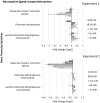Different as night and day: Behavioural and life history responses to varied photoperiods in Daphnia magna
- PMID: 31486145
- PMCID: PMC6856852
- DOI: 10.1111/mec.15230
Different as night and day: Behavioural and life history responses to varied photoperiods in Daphnia magna
Abstract
Nearly all animal species have utilized photoperiod to cue seasonal behaviours and life history traits. We investigated photoperiod responses in keystone species, Daphnia magna, to identify molecular processes underlying ecologically important behaviours and traits using functional transcriptomic analyses. Daphnia magna were photoperiod-entrained immediately posthatch to a standard control photoperiod of 16 light/ 8 dark hours (16L:8D) relative to shorter (4L:20D, 8L:16D, 12L:12L) and longer (20L:4D) day length photoperiods. Short-day photoperiods induced significantly increased light-avoidance behaviours relative to controls. Correspondingly, significant differential transcript expression for genes involved in glutamate signalling was observed, a critical signalling pathway in arthropod light-avoidance behaviour. Additionally, period circadian protein and proteins coding F-box/LRR-repeat domains were differentially expressed which are recognized to establish circadian rhythms in arthropods. Indicators of metabolic rate increased in short-day photoperiods which corresponded with broadscale changes in transcriptional expression across system-level energy metabolism pathways. The most striking observations included significantly decreased neonate production at the shortest day length photoperiod (4L:20D) and significantly increased male production across short-day and equinox photoperiods (4L:20D, 8L:16D and 12L:12D). Transcriptional expression consistent with putative mechanisms of male production was observed including photoperiod-dependent expression of transformer-2 sex-determining protein and small nuclear ribonucleoprotein particles (snRNPs) which control splice variant expression for genes like transformer. Finally, increased transcriptional expression of glutamate has also been shown to induce male production in Daphnia pulex via photoperiod-sensitive mechanisms. Overall, photoperiod entrainment affected molecular pathways that underpin critical behavioural and life history traits in D. magna providing fundamental insights into biological responses to this primary environmental cue.
Keywords: Daphnia behaviour; Daphnia life history; male production; photoperiod; phototaxis.
Published 2019. This article is a U.S. Government work and is in the public domain in the USA.
Conflict of interest statement
The authors declare no conflict of interest or relationship, financial or otherwise that might be perceived as influencing the authors' objectivity in the reporting of the study results or interpretations.
Figures




Similar articles
-
Effects of light regime on circadian rhythmic behavior and reproductive parameters in native laying hens.Poult Sci. 2022 May;101(5):101808. doi: 10.1016/j.psj.2022.101808. Epub 2022 Feb 25. Poult Sci. 2022. PMID: 35339931 Free PMC article.
-
Effects of photoperiod on growth, lipid metabolism and oxidative stress of juvenile gibel carp (Carassius auratus).J Photochem Photobiol B. 2019 Sep;198:111552. doi: 10.1016/j.jphotobiol.2019.111552. Epub 2019 Jul 9. J Photochem Photobiol B. 2019. PMID: 31382089
-
Photoperiodic control of annual reproductive cycle in subtropical brahminy myna, Sturnus pagodarum.Gen Comp Endocrinol. 1993 Jan;89(1):149-60. doi: 10.1006/gcen.1993.1018. Gen Comp Endocrinol. 1993. PMID: 8428647
-
Genomics of environmentally induced phenotypes in 2 extremely plastic arthropods.J Hered. 2011 Sep-Oct;102(5):512-25. doi: 10.1093/jhered/esr020. Epub 2011 Apr 27. J Hered. 2011. PMID: 21525179 Free PMC article. Review.
-
Global climate change and invariable photoperiods: A mismatch that jeopardizes animal fitness.Ecol Evol. 2019 Aug 16;9(17):10044-10054. doi: 10.1002/ece3.5537. eCollection 2019 Sep. Ecol Evol. 2019. PMID: 31534712 Free PMC article. Review.
Cited by
-
Comparative Transcriptome Analysis Reveals the Light Spectra Affect the Growth and Molting of Scylla paramamosain by Changing the Chitin Metabolism.Mar Biotechnol (NY). 2024 Apr;26(2):351-363. doi: 10.1007/s10126-024-10301-3. Epub 2024 Mar 18. Mar Biotechnol (NY). 2024. PMID: 38498104
-
Prolonged light exposure time enhances the photosynthetic investment in osmotrophic Ochromonas.Appl Environ Microbiol. 2025 Jul 23;91(7):e0103225. doi: 10.1128/aem.01032-25. Epub 2025 Jun 24. Appl Environ Microbiol. 2025. PMID: 40552826 Free PMC article.
-
Transcriptome analysis of different life-history stages and screening of male-biased genes in Daphnia sinensis.BMC Genomics. 2022 Aug 13;23(1):589. doi: 10.1186/s12864-022-08824-x. BMC Genomics. 2022. PMID: 35964016 Free PMC article.
-
Mode of action evaluation for reduced reproduction in Daphnia pulex exposed to the insensitive munition, 1-methyl-3-nitro-1-nitroguanidine (MeNQ).Ecotoxicology. 2021 Aug;30(6):1203-1215. doi: 10.1007/s10646-021-02447-w. Epub 2021 Jun 26. Ecotoxicology. 2021. PMID: 34173910 Free PMC article.
-
Pharmacological modulation of fish-induced depth selection in D. magna: the role of cholinergic and GABAergic signalling.Sci Rep. 2021 Sep 30;11(1):19407. doi: 10.1038/s41598-021-98886-w. Sci Rep. 2021. PMID: 34593892 Free PMC article.
References
-
- Alekseev, V. , & Lampert, W. (2006). Maternal effects of photoperiod and food level on the life history characteristics of the cladoceran Daphnia pulicaria . Hydrobiologia, 526, 225–230.
-
- Altshuler, I. , Demiri, B. , Xu, S. , Constantin, A. , Yan, N. D. , & Cristescu, M. (2011). An integrated multi‐disciplinary approach for studying multiple stressors in freshwater ecosystems: Daphnia as a model organism. Integrative and Comparative Biology, 51, 623–633. 10.1093/icb/icr103 - DOI - PubMed
-
- American Society for Testing and Materials (ASTM) . E1193 – 97 (Reapproved 2012). Standard guide for conducting Daphnia magna life‐cycle toxicity tests. West Conshohocken, PA: ASTM International.
-
- Ananthasubramaniam, B. , McCauley, E. , Gust, K. A. , Kennedy, A. J. , Muller, E. B. , Perkins, E. J. , & Nisbet, R. M. (2015). Relating suborganismal processes to ecotoxicological and population level endpoints using a bioenergetic model. Ecological Applications, 25, 1691–1710. 10.1890/14-0498.1 - DOI - PubMed
-
- Armitage, K. B. , & Landau, L. M. (1982). The effects of photoperiod and temperature on growth and reproduction of Daphnia ambigua A. Comparative Biochemistry and Physiology A, 71, 137–140. 10.1016/0300-9629(82)90379-6 - DOI
Publication types
MeSH terms
LinkOut - more resources
Full Text Sources
Molecular Biology Databases

